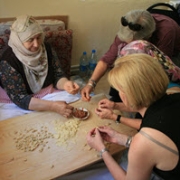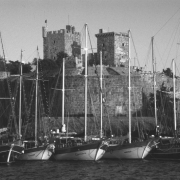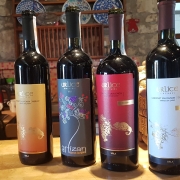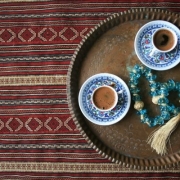Wild Greens of Aegean Turkey
/0 Comments/in Mother Earth, Travel & About /by Alper Ertubey
Popular Wild Greens Of Turkish Cuisine
| Turkish | English | Latin |
| Acı soğan | Arum, Lords & Ladies | Arum sp. |
| Arapsaçı - Bostanotu - rezene | Fennel sprouts | Foeniculum vulgare |
| Börülce | Cowpea | Vigna unguiculata |
| Cibes otu | First shoots of cauliflower | Brassica oleracea |
| Çirişotu | Summer Asphodel | Asphodelus aestivus |
| Deniz börülcesi | Samphire | Salicornia europaea |
| Deniz fasülyesi | Sea Beans | Salicornia sp. |
| Ebegümeci | Mallow | Malva sylvestris |
| Enginar | Artichoke | Cynara cardunculus |
| Hardal otu | White mustard greens | Sinapis alba |
| Isırgan otu | Nettle | Urtica urens |
| İstifno - İt üzümü | Leafy Goosefoot | Chenopodium foliosum |
| Kabak çiçeği | Pumpkin flower | Cirsium ciliatum |
| Kapari | Caper | Capparis spinosa |
| Kazayağı - Sirken | Many-seeded Goosefoot | Chenopodium polyspermum |
| Kuşkonmaz | Asparagus | Asparagus officinalis |
| Kuzukulağı - Labada | Sheep's sorrel | Rumex acetosella |
| Madımak | Knotweed | Polygonum cognatum |
| Mıhliye | Mallow | Corchorus olitorius |
| Papules | Sweet pea | Lathyrus ochrus |
| Radika - Hindiba | Endive, chicory | Cichorium endivia |
| Semiz otu | Common Purslane, Pusley | Portulaca oleracea |
| Suteresi - Gerdeme | Watercress | Nasturtium officinale |
| Sütotu | Milkwort | Polygala sp |
| Şevket-i bostan | Blessed thistle | Cnicus benedictus |
| Tarla börülcesi | Black Eyed Pea | Vigna unguiculata subsp. unguiculata |
| Turp otu | Horse raddish greens | Raphanus raphanistrum |
| Karabiber ağacı | Peruvian pepper | Schinus molle |
İzmir (ancient Smyrna) is the 3rd largest city in Turkey and the major port on the Aegean. Urla (ancient Klazomenai), Alaçatı (ancient Agrilia), Çeşme(ancient Cysus), Foça (ancient Phokaia), Ildırı (ancient Erythrai) are some of the small towns on İzmir Peninsula famous not only for history and beaches but also they are all culinary centers of the area known for wild greens, artichokes, and sea-food.
Since the İzmir area has become a scene for local festivals promoting the wild greens, herbs, and artichokes. In March and April, many visit this area for long week-ends visiting green markets, eat phenomenal food, and taste wine at Urla Wine Route, while the Aegean sun just starts to warm the earth.
In recent years, the Mediterranean diet has been promoted as a model for healthy eating. One of the main characteristics of the Mediterranean diet is an abundance of plant food as fruits, vegetables, whole-grain cereals, nuts, and legumes. This paper compiles and evaluates the ethnobotanical knowledge currently available on wild edible plants sold in the local markets and traditionally used for human consumption in Izmir, a province on the Mediterranean coast of Turkey. The information about the use of wild edible plants was collected from 18 different open-air-markets in the city during a two-year period, through unstructured interviews. In this study, a total of 46 wild edible plant taxa were established, and also plant parts used, ethnographic data related to vernacular names, traditional tools, and recipes were recorded. Family Asteraceae is represented by the highest number of taxa (7), followed by Apiaceae (6), Polygonaceae, Liliaceae, and Lamiaceae (4), Amaranthaceae, and Brassicaceae (2). The study showed that the plants used are either eaten raw, cooked by boiling in water, frying in oil or baked to be served as dishes such as stew, salad as a hot drink. During this ethnobotanical research, it was verified that wild edible plants play an important role in the diet in Izmir. However, it was observed that the transfer of folk uses of these plants decreased in the last generations. In this context, the ethnobotanical research about wild edible plants should be extended to other areas of Turkey in order not only to preserve the traditional knowledge related to plants but also to make it available for future generations as well.*
*Quoted from Yunus Dogan from his study on "Wild edible plants sold in the local markets of Izmir", Turkey Buca Faculty of Education, Dokuz Eylul University, 35150 Buca-Izmir, Turkey















Leave a Reply
Want to join the discussion?Feel free to contribute!